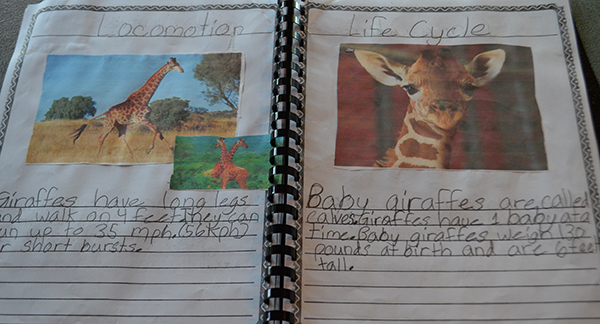We are nearing the end of the year (seriously summer can’t come soon enough) and my students are growing more hyper and less productive by the minute. In an effort to increase engagement and keep my sanity, I channeled their love of animals into a cumulative animal research unit. Follow these steps to implement this project in your room; download the complete unit here.
1. Create a research bulletin board: I created a research bulletin board with the text features poster set from Really Good Stuff. I enlarged an American black bear printout from enchantedlearning.com as my primary resource. I laminated 8 different colors of paper and hung up next to the bear printout; each color represents a different topic (i.e. anatomy, habitat, diet, etc.). I model how to record key words for each topic on corresponding card.
2. Select leveled nonfiction animal books: Look for books rich with text features (headings, captions, photographs, etc.) are best. I highly recommend selecting sets of these books for guided reading groups; this is a great way to teach children how to ask questions and effectively use text features to find answers in the text. National Geographic Kids and readinga-z.com offer a wide range of quality, engaging options.
3. Help children find research sources: I let each student pick animal to research (this promotes ownership and engagement) and print an animal printout from enchantedlearning.com. These printouts are easy to read and all include a diagram and headings. I send home a letter asking parents to send in supplemental research and colored photographs to use in report (I remind parents to preview first to avoid mating details and photos.)
During our research unit, I follow these steps:
1. Read a variety of animal nonfiction books, pointing out different features of nonfiction text and their purpose(s). I also use sets of leveled nonfiction texts during guided reading groups; students ask questions about the animal and use learned text features to find answers in the text.
2. Each student picks an animal and completes a KWL chart (included in the downloadable unit).
3. Explain the report process and review the rubric with them (included in the downloadable unit).
4. Model completing research with the American black bear printout from enchantedlearning.com. Each day I pick one topic to research (diet, anatomy, habitat, locomotion, etc.). If the topic is diet, model finding diet in the text. Write key words on that color-coded card. I organize the key words with bullets. They should fit all key words on one card; remind them not to copy whole sentences. If there is a word that students do not know, I have them highlight the word; these words will go into their glossaries.
5. Create an animal research report outline. First model how to write an interesting beginning (usually a question or interesting fact) along with a transition sentence. Model how to write a main idea and key fords for the supporting sentences. Students also write the heading above each main ideas so that it is ready for them when they draft. This outline can be completed during small group time.
6. Draft, edit, revise and publish report (drafting paper, table of contents and glossary are all included in the downloadable unit). Review elements of the rubric frequently and how to score each report using the rubric so students are familiar with expectations.
7. Share reports with class. Students can practice presenting to a partner or small-group before presenting to the whole class. This activity meets several listening and speaking Common Core State Standards. I put completed reports in the class library so students can read during silent reading time.
We’d love to hear any research project ideas you have!









